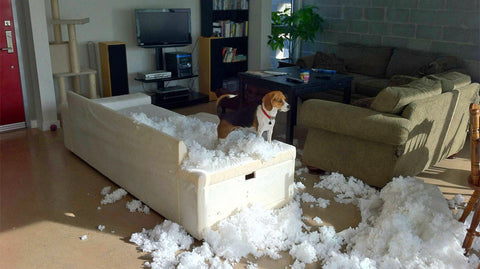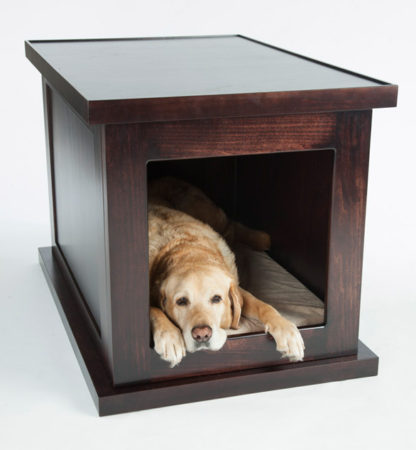How to Calm Down a Dog

Do you have a dog that is high strung and always on edge? Does the dog pace back and forth in your absence? Does he bark incessantly when you leave home or when there is even the slightest noise? Perhaps he exhibits some other negative behaviors like being destructive or urinating in inappropriate places. These may all be signs of dog anxiety.
Dog anxiety is a problem affecting 20 to 40 million dogs in America. There is separation anxiety that is common in adopted dogs and dogs who have experienced abuse in the past. Dog anxiety can be spurred by loud sounds like fireworks, thunder, loud cars or even by a knock on the door. Dog anxiety can be a mild to moderate problem or it may be a time consuming and frustrating issue for both pet and owner.
If owners confuse dog anxiety with misbehavior, it can make some issues worse. You see, the symptoms of dog anxiety are an expression of distress. They are not necessarily a disciplinary problem. It can be well worth an owner’s time and effort to explore solutions that can better relax a dog. A relaxed dog after all, is a happier, friendlier animal who will exhibit better behavior.
How to Calm a Dog Down When You are not Home
A thunderstorm, loud noise or knock at the door can trigger stress and anxiety in your dog at any time. That’s why one of the most critical aspects in choosing ways to calm your dog is selecting solutions that are available to your pet while you are not at home. Drug-related solutions or stress-vests may sound appealing, but if you are not there to help implement the solution, it is useless to your pet in your absence. If you really want to know how to calm down a dog, make sure solutions are available when you are not at home. The holistic solutions below can easily be put into use even when a guardian is not present.

Create a Den to Help Calm Your Dog Down
You shouldn’t underestimate how important a dog’s natural instincts are. One of these instincts is to seek a den-like atmosphere. If you’ve ever witnessed your dog hiding under the bed or in a closet during a thunderstorm, they are exhibiting this den-seeking behavior. You can help create a den for him that is comfortable, even in a crate. Make sure it has padding, a chew or other favorite toy, has ample room, and is insulated from stress-inducing outside sounds. Pillows, curtains, or sheets can create this den-like environment. Keep in mind, your dog is going to want his den near his “pack”, which, in this situation, is your family. Your dog’s den should be in a family or living room area where your family spends most of their time.
How to Calm an Anxious Dog
Many guides on how to calm an anxious dog include tips on including a fan and soft music to a dog’s favorite area. If you’ve ever seen the joy on a face of a dog sticking his head out a moving car window you can appreciate how moving air pleases most dogs. Make sure the fan is secure and the dog can’t harm itself with its moving blades. Relaxing music can also help sooth an anxious dog when used in combination with other holistic approaches. While a radio may provide sound, make sure it is calming.
How to Calm Down a Dog Using Technology
Today, technology can play a role in calming a dog down holistically. One example is the innovative ZenCrate. This is a furniture-quality dog crate that combines the holistic features above with smart technology. Proximity sensors activate features when the dog enters ZenCrate. These include a motion-activated fan and soothing motion activated music that has been researched to provide a calming effect. An add-on camera takes advantage of ZenCrate’s WiFi capabilities and keeps owners visually connected with their pet. Owners even get an email making them aware of the dog’s activity. A battery back-up is included to keep ZenCrate’s calming features functioning even in the event of a power failure during a thunderstorm. But it’s not just technology that makes ZenCrate so effective.

Engineer’s have built den-like qualities right into the ZenCrate including comfortable orthopedic memory foam padding, sound absorbing acoustics, and vibration-dampening feet. The ZenCrate’s door insert can easily be removed to provide easy access for your pet. The product was specifically designed to provide calming benefits even if the owner or guardian is not present.
The ZenCrate is simple to assemble without tools and can quickly be put to use in your efforts to calm your dog…with one caveat. ZenCrate is not quite available for sale…yet. However, if you would like to be kept informed on when ZenCrate does become available and get a special invitation to be one of the first to own one, now is the time to act. Get the value of multiple holistic solutions to dog anxiety in one creative product. Visit the ZenCrate website and sign-up today!





